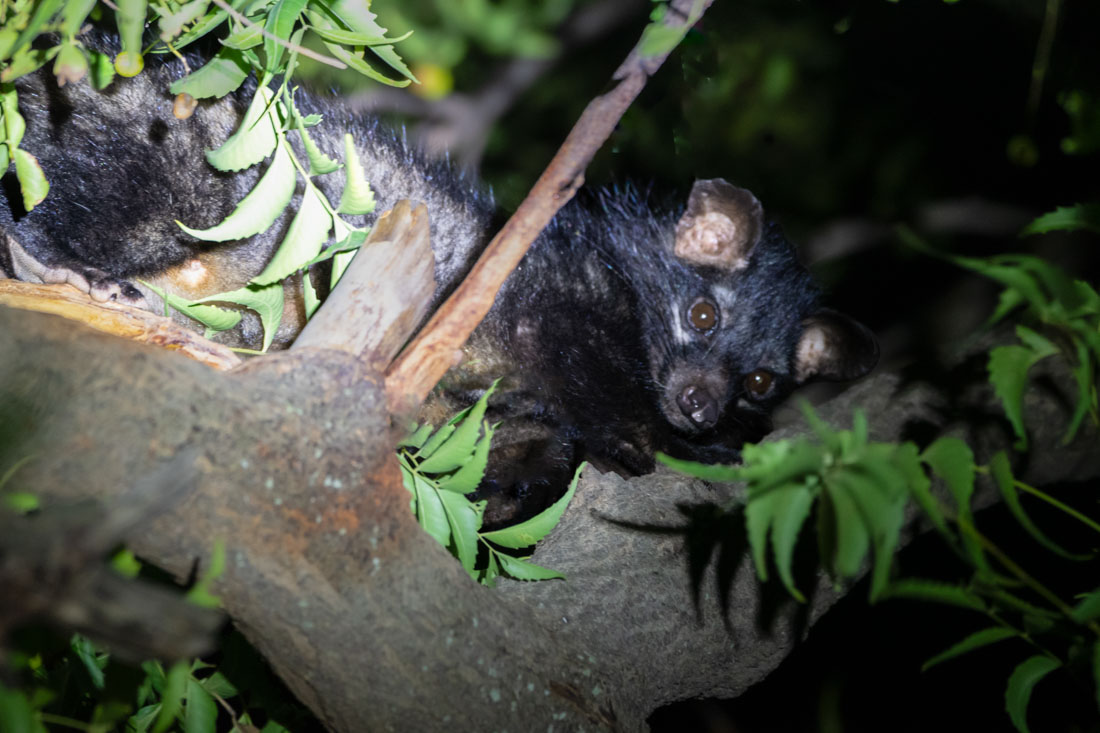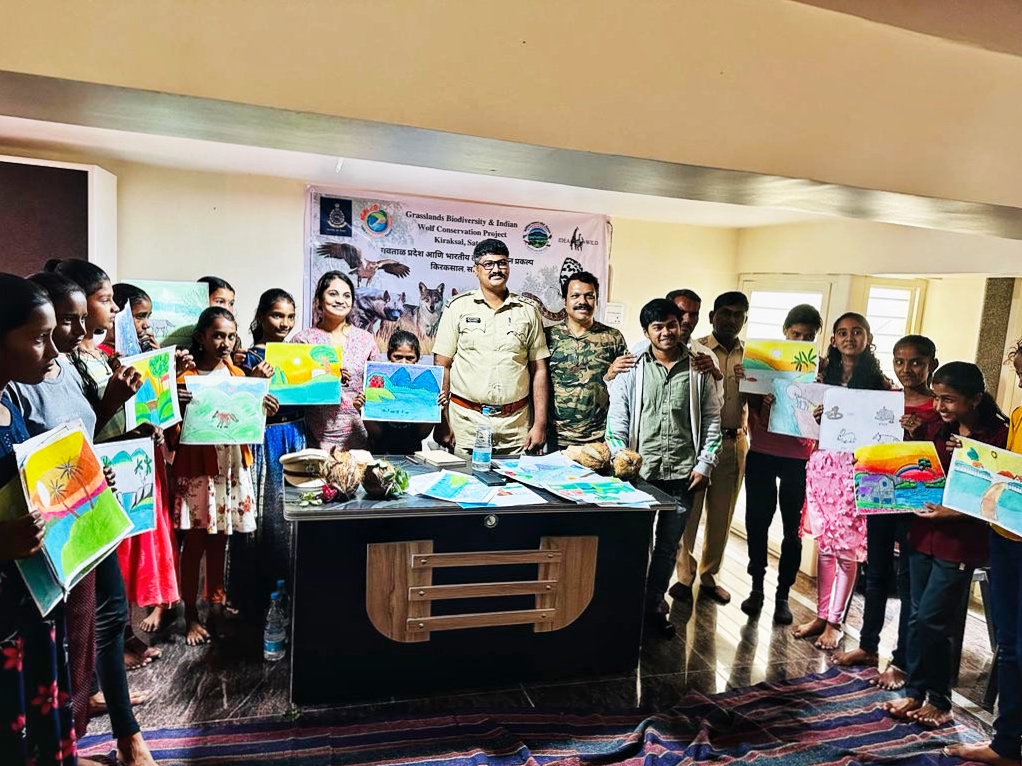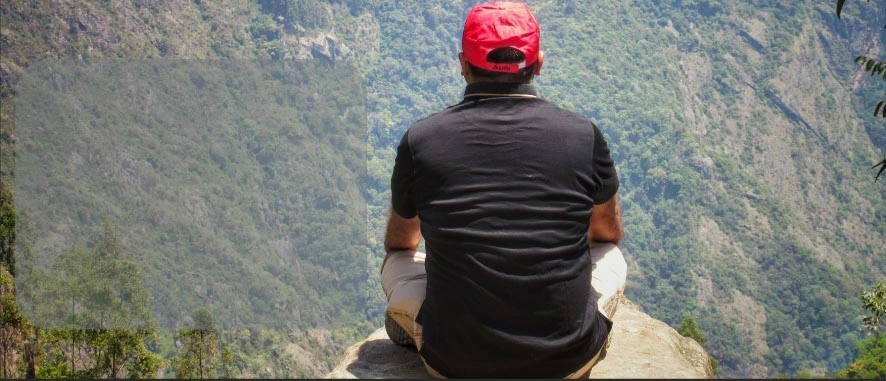
1,419 views

Chronicles of Biodiversity in Kiraksal
By Rahuldev Rajguru
Last Updated: 05 Nov 2023
In the quiet corners of my Inbox, amid the usual flood of emails, there came a subtle ping that changed the course of my travels. It was an unassuming message from a mailing list I was part of, a community of nature enthusiasts and wanderers. The subject line read 'Kiraksal Biodiversity Conservation Project.” Intrigued, I opened the email, and as my eyes scanned the words, I found myself captivated by the tale it told.
Nestled within the lines was a revelation that immediately sparked my imagination - the grasslands of Kiraksal, a name I had barely heard before, were not just ordinary fields. No, they were extraordinary havens, inhabited by elusive wolves, other members of the Canidae family and more than two hundred birds. The idea of sharing a space with these majestic creatures, experiencing their untamed world, was an irresistible lure.
This newfound knowledge transformed Kiraksal from a mere name to a realm of intrigue. The idea of encountering these wild canids, observing their behavior, and capturing their essence through my lens fascinated me. It was more than a journey; it was a chance to witness nature's drama unfold in a place where every rustle of grass and every distant howl held a story waiting to be told.

The idyllic landscape of Kiraksal is characterized by table-top mountains and distant windmills
So, with the echo of distant wolves calling me, I set forth on a quest to Kiraksal, not just as a traveler, but as a storyteller seeking to unravel the mysteries of these grasslands. Little did I know that this adventure would not only bring me face-to-face with the wilderness but also with the untamed spirit within myself.
What fascinated me most was not just the diversity of life in this tiny village of Kiraksal, but the stories hidden within its wilderness. Stories of rare species, native tribes, and the silent struggle for coexistence. It was this hidden narrative, waiting to be unveiled, that propelled me to pack my bags and embark on a journey to Kiraksal.

Kiraksal grasslands are home to an increasing number of Jackals
In the realm of Internet and instant connections, I swiftly summoned the wisdom of Google, my modern-day compass, in pursuit of Kiraksal. Among the myriad search results, one name shimmered like a hidden gem - Chinmay Sawant, a young visionary in his early 20s, aflame with fervor for the wild. His passion for biodiversity conservation was palpable even through the screen, a beacon drawing kindred spirits like moths to a flame.
With a heart brimming with curiosity, I reached out to him, not expecting much from a simple message sent into the vast void of the internet. To my astonishment, his response was not just prompt but laced with a genuine warmth that transcended the digital divide. His words carried the essence of Kiraksal's allure, and in his encouragement, I found the wind beneath my wings.
Chinmay, this spirited young guardian of the wilderness, extended a gracious invitation. In his words, I sensed the pulse of the grasslands, the whispering leaves, and the silent footfalls of creatures unseen. Not content with mere words, Chinmay took it upon himself to orchestrate my journey. Not only did he arrange my stay and sustenance, but also mapped out the intricate trails that led to Kiraksal.
Introduction to Kiraksal Village
Kiraksal, a quaint village nestled in the Satara district of Maharashtra, boasts a population of a mere 1,500 residents. Just 5 kilometers away lies the renowned town of Gondavale BK, celebrated for its sacred shrine dedicated to Gondavalekar Maharaj, a prominent Hindu saint. Kiraksal's origins traces back to a benevolent act by Gondavalekar Maharaj. It is believed that he generously bestowed this land upon his devout followers for agricultural purposes, thus giving birth to Kiraksal.
What sets Kiraksal apart is its distinctive landscape. Spanning 1,800 hectares, the village is cocooned amidst vast expanses of grasslands, tabletop mountains, and serene wetlands. This unique topography creates an idyllic setting, making Kiraksal a gem in the heart of nature. Remarkably, the village is ensconced within a forest, with no neighboring settlements in sight for quite a distance.

Kiraksal is enveloped by verdant agricultural fields cultivating crops of sugarcane and millet
I found the village's commitment to a communal way of life truly remarkable. The residents coexist harmoniously, extending a helping hand to one another. This cooperative spirit is indicative of the village's overall prosperity, primarily attributed to their flourishing agricultural practices. A mere decade ago, Kiraksal was a barren expanse, limited to cultivating basic pulses and cereals. However, the introduction of an efficient canal system has revolutionized their agricultural landscape. Today, the village boasts bountiful harvests of diverse crops such as millet, wheat, soybean, sugarcane, watermelon, and grapes. Notably, the village produces an impressive 3,000 liters of milk daily and houses a few poultry farms on its outskirts. Visits to Kiraksal brought back memories of my visit to Kokkarebellur, a community reserve in Karnataka.

Kiraksal thrives on rich crops, thanks to a continuous water supply from the extensive canal system
During my visit, I had the privilege of conversing with Mr. Amol Katkar, the village chief (sarpanch). Mr. Katkar, a young and dynamic leader, envisions a future for Kiraksal rooted in sustainable development and biodiversity conservation. In addition to fostering a delicate balance between progress and conservation, his dedication is evident in his efforts to achieve village self-sufficiency. His passionate initiatives stand as a testament to Kiraksal's evolving story of growth and harmony.

The contemporary Gram Panchayat office building in Kiraksal stands as a testament to the community's vision of prosperity and progress
Wildlife in Kiraksal
Kiraksal stands as a haven for wildlife enthusiasts, where expansive grasslands and rolling hills offer a perfect backdrop for captivating wildlife sightings. Abundant vegetation, water sources, and enough prey base provide a nurturing environment for various species. Interestingly, the wildlife remained largely undocumented until you hear an oral account of some of the elders. However, in 2018, spurred by the National Biodiversity Authority (NBA), the State Biodiversity Board initiated comprehensive documentation. This initiative birthed the People's Biodiversity Register (PBR) and Biodiversity Management Committee in every gram panchayat (villages) across Maharashtra, including Kiraksal.

Expansive grasslands nurture diverse wildlife, transforming Kiraksal into a paradise for nature enthusiasts
This impetus led Kiraksal's residents to meticulously record wildlife and vegetation data. A dedicated team was formed, tasked with systematically documenting every aspect. As of 2022, their efforts have unveiled a vibrant biodiversity in Kiraksal: 204 bird species grace the skies, 84 species of butterflies dance amidst the flora, while 17 mammals, 35 reptile and amphibian species, and over 200 plant species add to Kiraksal's rich natural heritage.

The rich biodiversity of Kiraksal supports a diverse range of wildlife
Conservation Catalyst India Project by WWF India
In May 2023, WWF India initiated a groundbreaking Wolf Conservation project in Kiraksal, injecting fresh energy into the local community. This endeavor not only brought vital funding but also valuable training, equipment, and, most importantly, motivation to bolster local conservation endeavors. The project entails a comprehensive study, meticulously documenting every species within Kiraksal, including their distribution across different areas and their behavioral patterns. A significant milestone was achieved as camera traps were introduced for the first time in Kiraksal, sparking immense enthusiasm among local volunteers. Witnessing their excitement firsthand, I was shown captivating videos and photographs captured through these camera traps, marking a transformative moment for wildlife conservation in Kiraksal.

In this picture taken at midnight, a Palm Civet crouches gracefully between branches of a tree
Diverse Wildlife Abundance
Kiraksal boasts a rich array of animals from the Canidae family, including approximately 4-5 endangered Indian Wolves, 10-12 Jackals, 5-6 Hyenas, and over 15+ Indian Foxes. Additionally, the village is a habitat for various other mammals, such as more than 20 Indian Hares, 10+ Porcupines, and over 8 Wild Boars, with their population steadily increasing. The Wild Boars are a recent addition to Kiraksal's biodiversity, thriving and multiplying in the area.

An Indian Hare caught under the flashlight in Kiraksal wilderness
While Blackbucks were once a common sight in the forest during the 1950s, their appearances have become rare in recent times. Elders in the village reminisce about a time when Blackbucks were abundant, but due to deforestation and hunting, these majestic creatures migrated elsewhere, marking a shift in Kiraksal's wildlife landscape. Bisons have been sighted in the village a few times, but they have largely remained migratory.

A flying fox hanging on electric cables during the day
Wolf Day in Kiraksal
Remarkably, Kiraksal stands as the only place in India where the spirit of International Wolf Day comes to life every August 13. This tradition commenced in 2021 and has since evolved into an annual event for the village. Despite its modest size, Kiraksal transforms into a festive hub on this day. The villagers extend warm invitations to forest authorities from different parts of the state, culminating in a grand celebration. The day is marked by presentations, including a noteworthy event and a wilderness luncheon, creating a lively atmosphere that echoes with the spirit of conservation and camaraderie. Additionally, the residents perform wolf-themed dances and sing traditional songs.

As part of the Wolf Day in Kiraksal, artists created intricate wolf-themed paintings
Venturing into the Wild of Kiraksal
During my stay in Kiraksal, immersing myself in the heart of the wilderness became a daily ritual, twice a day. Recognizing the vitality of the forest during the nocturnal hours, I was fortunate to have Chinmay arrange two exceptional guides, Abhi and Prathamesh, whose expertise in the landscape was unparalleled. They possessed an intricate understanding of Kiraksal's terrain, guiding me through the forest with remarkable precision.

I could not have enjoyed my visit to Kiraksal without Prathamesh (left) and Abhi
Abhi and Prathamesh delved into the depths of the Kiraksal range, comprehending every contour and corner of the landscape. Their mastery extended to recognizing the habitats of the native wildlife, deciphering their behaviors, and locating their burrows. Armed with high-powered flashlights, their keen eyes could spot animals even at a considerable distance. Their swift movements mirrored the pace of the wildlife, ensuring we didn't miss any captivating moment. However, navigating my camera with a bulky telephoto lens at such speed posed a significant challenge for me. Their expertise was evident during our encounters with Jackals, Hyenas, and Indian Foxes, where their knowledge allowed us to observe these creatures up close.

In the darkness of Kiraksal, Indian foxes saunter across the grasslands
Capturing the elusive Indian Hare during dark hours proved to be a significant challenge, its speed often surpassing even the swift movements of our flashlights. Despite this, with the guidance of Abhi and Prathamesh, I managed to capture some nice clicks. The nocturnal exploration also included encounters with reptiles and amphibians in the shadows. We were fortunate to spot Indian Nightjars, both adults and juveniles. Abhi and Prathmesh demonstrated remarkable skill in detecting this well-camouflaged bird swiftly. They expertly positioned their flashlights at the perfect angle, enabling me to capture striking shots of this elusive creature.

There is a recent influx of wild boars into Kiraksal grasslands
As the saying goes, the darkest corners indeed harbor the wildest wonders. Every moment spent in Kiraksal's wilderness became an unforgettable experience under the guidance of these exceptional guides.

Indian Nightjars, masters of camouflage, blend into Kiraksal's grasslands during the dark hours
Mitigating Human-Animal Conflict
When a village is nestled within the heart of a bustling forest, the potential for human-animal conflicts becomes almost inevitable. However, Kiraksal has managed to defy this norm. Despite falling under the jurisdiction of the Maharashtra Forest Department, I was intrigued by the absence of forest guards within the woods. I was informed that the village had undertaken numerous educational and awareness programs in the past that emphasized coexistence with wildlife. Residents received awareness on the integral role of biodiversity in the delicate balance of nature.
Information boards strategically placed throughout the area reinforced the principles of harmonious co-existence and the prohibition of hunting. Notably, the residents themselves now actively monitor and discourage individuals from neighboring regions who visit Kiraksal with hunting intentions. This collective consciousness has dissuaded outsiders from using Kiraksal as a hunting ground. The residents of Kiraksal have also been sensitized not to venture into other villages for animal hunting. Moreover, Kiraksal's residents are well-informed about the importance of refraining from tree felling, recognizing the vital role trees play in providing sustenance for the local fauna.

Nestled amidst the grasslands forest, Kiraksal finds its serene home
In the event of a wild animal preying on a farmer's livestock, the forest department compensates the affected farmer, a crucial measure to prevent retaliatory actions against the animals. During my visits, we encountered these creatures at remarkably close distances, yet they never exhibited aggression. This non-confrontational behavior suggests that the animals do not perceive humans as threats, a testament to the success of Kiraksal's efforts in fostering a harmonious environment.
Biodiversity Conservation Project
At the core of Kiraksal's ethos lies a deep commitment to biodiversity conservation, a passion that resonates throughout the community. Chinmay, a dedicated member, plays a pivotal role in the committee spearheading these conservation endeavors. Their vision extends to the establishment of the Kiraksal Ecological Research and Conservation Foundation, a non-government organization (NGO) geared toward raising awareness and promoting biodiversity conservation, not only within Kiraksal but also in neighboring villages such as Bombale, Dambhewadi, and Kalewadi. The NGO will operate in the Mandesh region (region of the Maan river basin in Western Maharashtra comprising Satara, Sangli, and Solapur district). This contiguous forest integrates seamlessly with these villages, thereby forming a shared ecosystem.

A vantage point offers a panoramic expanse of Kiraksal forest, complemented by the distant Choramale dara waterbody
The conservation initiatives in Kiraksal are meticulously organized around four fundamental pillars, aptly named the "4 sutras" of conservation. These pillars serve as the guiding principles.
(1) Vanvabandi - prevent forest fire
(2) Shikarbandi - no hunting or poaching of wildlife
(3) Kuradbandi - no cutting of trees
(4) Charaibandi - prevent complete grazing of grass by livestock so that the grass remain reproductive
Birding in Kiraksal
Kiraksal, beyond its vibrant wildlife, stands as a haven for bird enthusiasts. The sprawling grasslands, adorned with numerous large and small waterbodies, create an ideal habitat for a diverse avian population. With over 200 species of birds, Kiraksal hosts a remarkable variety. This avian community spans across different bird families, encompassing the following.
- Larks
- Pipits
- Sparrows
- Shrikes
- Finches
- Owls
- Shore birds
- Large wading birds
This rich avifauna transforms Kiraksal into a paradise for birders, offering a captivating opportunity to observe and appreciate the vibrant birdlife in their natural habitat.

Great Gray Shrike

Spotted Owlet
In the embrace of monsoon, Kiraksal transforms into a mesmerizing spectacle, adorned by the intricate craftsmanship of Baya Weavers. It turns into a breeding ground for these skilled avian architects. As the rains grace the land, numerous trees come to life, their branches festooned with the meticulously woven nests of Baya Weavers, some trees bearing the weight of up to 25 nests. It became an enchanting experience for me to watch these beautiful birds in action, drawing the attention of curious locals. In fact, they even invited me to their farm in order to show off the trees adorned with these avian creations. It brought them great pride to have an outsider recognize the diversity of their surroundings.
Baya Weavers building their nests in one of the trees in Kiraksal
Avian Encounters by the Water Canal
My morning ritual in Kiraksal included a long walk along the water canal with my camera. The canal was surrounded by agricultural fields, where millets, wheat, and various crops flourished, providing abundant food for birds. The air was filled with the melodic chirping of birds, harmoniously blending with the gentle flow of water in the canal. As soft sunlight filtered through the leaves, it cast a subtle glow upon the surrounding area, creating a serene atmosphere.

Pied Bushchat (Male)

Scaly-breasted Munia
The sight of hundreds of house sparrows perched on millet crops left me utterly mesmerized. In urban areas, especially in larger cities, these delightful creatures have sadly become extinct from our everyday lives. However, in Kiraksal, their abundant presence brought a wave of nostalgia rushing over me.

A House Sparrow perched on a millet stalk
Exploring Feathered Friends by the Lake
A place that captured my heart for birding was Nali Grasslands, which has a man-made lake approximately 5 km from Kiraksal. Known in Marathi as Wadakeshetalav because of its majestic banyan tree, this picturesque lake sits majestically on an elevated perch. From this vantage point, it treats visitors to a breathtaking panorama of expansive grasslands and rolling hills, painting a mesmerizing scene that feels almost surreal. As the sun sets over the lake, it casts a warm golden hue over the landscape, and a sense of serenity and tranquility envelops you, making it the perfect time to enjoy the lake's beauty.

Stunning panorama from Wadakeshetalav Lake in Kiraksal
The waterbody serves as a sanctuary for a myriad of vibrant bird species, such as Cormorants, Ibises, Storks, Sandpipers, and Sandgrouses. Among these fascinating creatures, my luck shone brightly when I spotted an active pair of Indian Thick-knee, a bird known for its nocturnal habits, making the encounter all the more special. Capturing the essence of this avian haven, I cherished the moments spent photographing grassland birds against the scenic backdrop of water.

A pair of Indian Thick-knee

Chestnut-bellied Sandgrouse

Ashy-crowned Sparrow-Lark (Male)
Migratory Birds
Grasslands possess an inherent allure for a diverse array of migratory birds, and Kiraksal stands as no exception to this natural phenomenon. In the vicinity of Kiraksal, two other wetlands, Yeralwadi and Pingali Lake, come alive every winter with the arrival of an impressive 250-300 species of migratory birds. These serene pastures provide the perfect foraging habitat for migratory birds from across the globe, which make these awe-inspiring landscapes their home for a few months each year. What adds to the fascination is the geographical arrangement of these locations, forming a convenient triangle on the map. This unique layout allows enthusiasts and nature lovers alike to seamlessly shuttle between them.
Sustainable Tourism in Kiraksal
Nestled far from the tourist radar, Kiraksal, with its hidden natural wonders, remains a haven for nature and wildlife enthusiasts. Due to its sheer obscurity, this place has preserved its biodiversity, since it lacks accommodations and restaurants, preventing mass tourism. This isolation, while protective, also presents a unique opportunity for sustainable tourism development. By embracing eco-friendly practices and community engagement, Kiraksal can open its doors to responsible travelers, providing them with an authentic and unspoiled experience.
Striking that balance
The absence of commercial establishments not only preserves the local environment but also acts as a blank canvas for creating sustainable tourism initiatives. By fostering responsible tourism, Kiraksal can channel resources towards the conservation of its unique ecosystem. This approach will not only bolster the local economy and create employment opportunities but also encourage nature enthusiasts to actively participate in conservation efforts. Striking a delicate balance between catering to tourists' interests and preserving the natural habitat is paramount. By cultivating mindful tourism practices, Kiraksal can transform into a model for sustainable tourism, ensuring the well-being of the village, its residents, and the precious biodiversity it harbors.
Disclaimer: This blog may contain affiliate links. At no extra cost to you, we may get a small commission if you buy anything. All products and services we endorse have been personally used or come highly recommended to us. These incomes allow us to keep the community supported and ad-free.
Things To Consider
About the author
Rate the Story
Related Stories
Please share your comment
Wonderful write up and unique way of sharing experiences of wilderness. A very apt of exploring hidden gem of our country and making others feel being part of your journey.







Name
Email
Comment